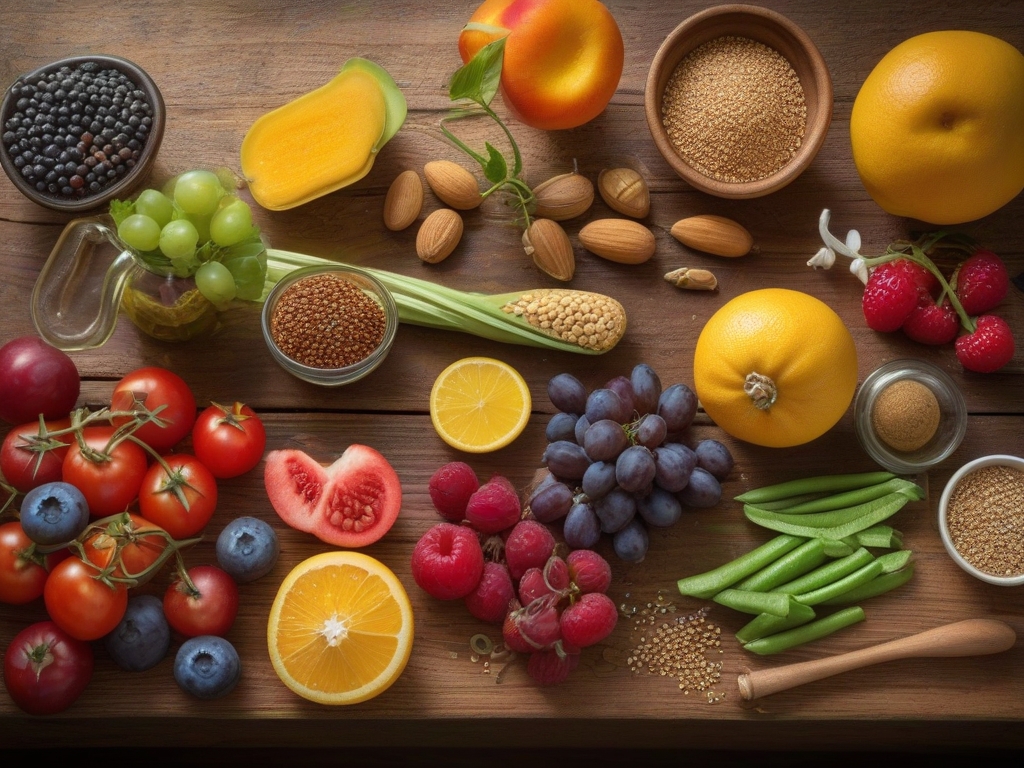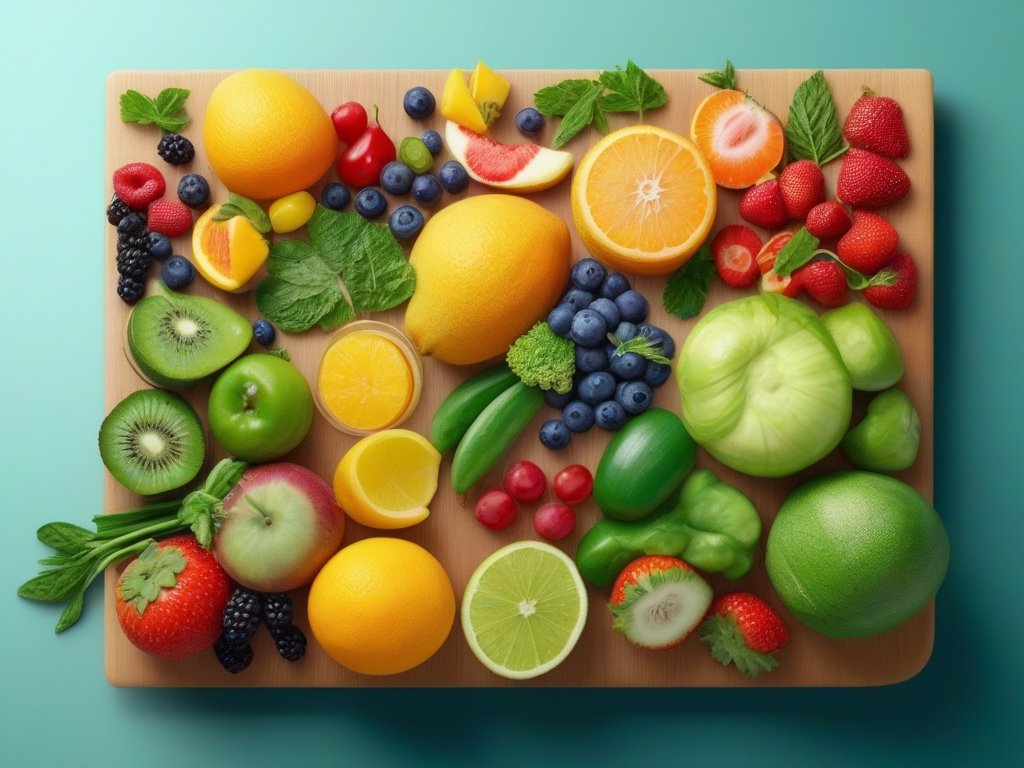Healthy Food Dishes
DATE : 11 October 2024 By : Tareq Qteshat

Starting Your Day with Nutritious Options
Whole-grain toast, oatmeal, and quinoa are nutritious breakfast options that set you up for a healthy day.
Adding lean proteins like eggs and Greek yogurt can provide an energy boost. These foods provide essential vitamins and minerals, and help keep your energy levels steady throughout the morning.
Wholesome Lunch Ideas
For lunch, consider using whole-grain wraps with roasted vegetables and lean protein.
This combination provides sustained energy and helps keep your digestive system running smoothly. The fiber from the whole-grain wrap and vegetables can also help lower cholesterol levels and regulate blood sugar.
Healthy Dinner Recipes
Dinners featuring plant-based protein sources, brown rice, and a variety of vegetables can make a significant difference in your overall health.
Plant-based protein sources like lentils, chickpeas, and black beans are rich in fiber, vitamins, and minerals. Brown rice provides sustained energy, while a variety of vegetables adds fiber, vitamins, and minerals to your meal.
Healthy Snacks and Desserts
Fresh snack alternatives like fruits and carrot sticks with hummus can curb your cravings for unhealthy foods.
Superfood-infused meals and delicious dessert options like fruit salads and dark chocolate can also be part of a healthy diet. By incorporating these foods into your diet, you can improve your overall well-being and reduce your risk of chronic diseases.
Key Takeaways
Starting the Day Off Right
A balanced breakfast sets the tone for a nutritious day. This meal should include complex carbohydrates, such as whole grains, lean protein, and healthy fats. Eating a balanced breakfast has been shown to have a positive impact on overall health and energy levels.
The Importance of Whole Grains
Whole grains like quinoa, brown rice, and whole-wheat bread are rich in essential fiber, vitamins, and minerals. These nutrients play a critical role in maintaining a healthy digestive system, supporting healthy blood sugar levels, and even helping to lower cholesterol. Incorporating whole grains into meals can have a significant impact on overall health.
Creating a Healthy Plate
Incorporating a variety of vegetables and lean proteins into meals is essential for maintaining overall health and well-being. Vegetables are rich in vitamins, minerals, and antioxidants, while lean proteins provide the necessary building blocks for healthy muscles and tissues. By combining these foods, individuals can create a balanced and nutritious meal.
Healthy Snacking Options
Combining nutrient-dense foods like fruits, nuts, and seeds creates healthier snack options. These foods are rich in fiber, protein, and healthy fats, making them a satisfying and nutritious choice. By choosing these foods, individuals can avoid unhealthy snacking habits and maintain a balanced diet.
Maintaining a Balanced Diet
Prioritizing whole foods and controlling portion sizes is essential for maintaining a balanced diet. By focusing on whole, unprocessed foods, individuals can avoid unhealthy additives and preservatives found in processed foods. Additionally, controlling portion sizes can help individuals maintain a healthy weight and reduce the risk of chronic diseases.
"A healthy diet is the foundation of a healthy life. By making informed food choices, individuals can take control of their health and well-being."
Nutritious Breakfast Options
The Importance of a Nutritious Breakfast
Starting your day with a balanced meal can have a significant impact on your overall health and well-being. A nutritious breakfast provides your body with essential nutrients, vitamins, and minerals, which helps jump-start your metabolism and boosts energy levels.
It also improves concentration, enabling you to tackle daily tasks with greater ease.
Incorporating Protein-Rich Foods into Your Breakfast
Including protein-rich foods like eggs, Greek yogurt, and whole-grain cereals in your breakfast can help you feel full and satisfied throughout the morning.
Fruits like berries, bananas, and citrus fruits are rich in antioxidants and fiber, which aid in digestion and enhance your immune system.
Nuts and seeds like almonds, walnuts, and chia seeds provide healthy fats and are rich in fiber and protein.
Whole-Grain Options for a Balanced Breakfast
Whole-grain toast, oatmeal, and quinoa are excellent sources of complex carbohydrates.
These foods release energy slowly, keeping you full and focused throughout the morning.
Adding a glass of low-fat milk or a plant-based milk alternative to your breakfast provides you with calcium, essential for maintaining strong bones and teeth.
Taking Control of Your Health
Making informed choices about your breakfast enables you to take control of your health and well-being.
By adapting your breakfast choices to cater to specific dietary needs and preferences, you can ensure that you're providing your body with the nutrients it needs to function at its best.
As the saying goes, "A healthy breakfast is the foundation of a healthy day."
Wholesome Lunch Ideas
Nourishing Your Body with Wholesome Lunch Ideas
As the morning energy wears off, a nutritious lunch becomes essential to maintain energy levels and support overall health.
A balanced meal should include a combination of complex carbohydrates, lean protein, and healthy fats. Whole grains like brown rice, quinoa, and whole-wheat bread are rich in fiber and vitamins. Lean proteins such as chicken, fish, and legumes provide essential amino acids.
Adding leafy greens like kale or chard can boost the nutritional value of your meal. These greens can be grown at home using space-saving techniques like vertical gardening or container gardening. Companion planting with herbs like parsley or cilantro can add flavor and texture to your leafy greens.
Incorporating a variety of vegetables like bell peppers and cucumbers can add freshness to your meal. Fresh fruits such as berries, citrus fruits, and apples are also rich in antioxidants and fiber. Healthy fats like avocado, nuts, and seeds aren't only delicious but also support heart health.
Some healthy lunch ideas include whole-grain wraps with roasted vegetables and lean protein, salads with mixed greens and a variety of vegetables, and brown rice bowls with grilled chicken and steamed vegetables.
Creating a nutritious and satisfying lunch can fuel your body and support your overall well-being.
"Eating a balanced lunch isn't just about filling your stomach, but also about nourishing your body and mind."
Healthy Dinner Recipes
Nutritious Dinner Ideas for a Healthier You
A balanced dinner plays a significant role in regulating blood sugar levels, supporting weight management, and promoting quality sleep.
To create a healthy dinner, combine lean protein sources, whole grains, and a variety of vegetables. Incorporating plants with sturdy stakes and poles, such as peas or beans, can provide additional nutrients and add freshness to meals.
Proper staking and tying these plants also promotes healthy growth and stability in the garden, resulting in better yields.
Some examples of nutritious dinner recipes include grilled chicken or fish with roasted vegetables, quinoa and black bean bowls, and stir-fries with lean beef or tofu.
Plant-based protein sources like lentils, chickpeas, and tempeh can also be used to create delicious meals. When cooking, use herbs and spices to add flavor instead of relying on salt and sugar.
Choosing cooking methods that retain the nutritional value of ingredients, such as steaming, grilling, or roasting, can also make a significant difference.
Incorporating a variety of colors on your plate ensures you're getting a range of essential nutrients.
Fresh Snack Alternatives
Fresh Snack Alternatives for a Healthier Lifestyle
Reaching out to nature provides an array of options that not only satisfy your cravings but also nourish your body. Fruits like apples, bananas, and berries are packed with essential vitamins, minerals, and antioxidants that help maintain peak health.
These nutrients are vital for maintaining strong immune systems and overall well-being.
Incorporating nuts and seeds like almonds, walnuts, and pumpkin seeds into your diet can also have numerous health benefits. Rich in healthy fats and protein, these snacks can help curb hunger and provide a feeling of fullness.
A well-planned meal strategy can also make a significant difference in maintaining a healthy diet. Learning to eat healthy, even as a picky eater, can greatly impact overall health and well-being.
If you're looking for a crunchy and nutritious snack, try vegetable sticks with hummus or guacamole dip. Cucumbers, carrots, and bell peppers are all great options that provide a good source of fiber and vitamins.
Energy balls made with rolled oats, honey, and nuts are another great option. These bite-sized snacks aren't only delicious but also packed with fiber and protein.
Incorporating these fresh snack alternatives into your diet can have numerous health benefits. A diet rich in fruits, nuts, and seeds can help with weight management and improve digestion.
It can also reduce the risk of chronic diseases like heart disease and diabetes. A well-balanced diet is essential for maintaining peak health, and making informed choices about the food you eat is crucial for overall well-being.
"A healthy diet isn't just about what you eat, but also about what you avoid." Making healthy choices can be challenging, but the benefits are well worth the effort.
Superfood Infused Meals
Incorporating Nutrient-Dense Foods into Your Diet
Incorporating nutrient-dense foods into your diet goes beyond just having healthy snack options. Infusing your meals with superfoods rich in antioxidants, vitamins, and minerals can have a significant impact on your overall health. These superfoods can help boost energy levels, support immune function, and reduce inflammation.
| Superfood | Nutrient Profile | Meal Ideas |
|---|---|---|
| Salmon | Rich in omega-3s, vitamin D, and selenium | Grilled salmon served with quinoa and steamed vegetables |
| Spinach | Rich in iron, calcium, and vitamins A and K | Spinach and feta stuffed chicken breast with roasted sweet potatoes |
| Sweet Potatoes | High in vitamin A, fiber, and minerals like potassium and iron | Sweet potato and black bean tacos with avocado salsa |
When preparing meals with superfoods, it's essential to pair them with other nutrient-dense ingredients to maximize their health benefits. Experimenting with different cooking methods and recipes can help you incorporate superfoods into your diet. This approach will help you take proactive steps towards supporting your overall health and wellbeing.
As you explore the world of superfoods, remember to prioritize variety in your diet. Combining different superfoods with other nutrient-dense ingredients can help you reap the rewards of a balanced diet. With a little creativity, you can make superfoods a staple in your diet and start experiencing the benefits they have to offer.
Delicious Dessert Options
Healthier Dessert Options for a Balanced Diet
When searching for healthier dessert options, consider desserts that feature natural sweetness from fruits, combining taste with essential nutrients. Low-calorie sweet treats can also be a good choice, using alternative sweeteners or portion control to reduce sugar intake.
For individuals who are picky eaters, finding the right healthy dessert can be challenging.
However, custom meal plans can provide inspiring ideas. When creating a meal plan, include healthy dessert options to satisfy your sweet tooth while maintaining a balanced diet.
A well-planned diet that includes healthy desserts can be beneficial for overall health.
A healthy dessert option can be as simple as a fruit salad or a low-sugar cake made with alternative sweeteners.
These options not only satisfy your sweet craving but also provide essential nutrients and fiber.
Fruit-Based Dessert Options
Fruit-Based Dessert Options: A Healthier Alternative
When exploring sweet treats, fruit-based desserts offer a healthier alternative to traditional desserts, often with fewer calories and added sugars. These desserts not only satisfy your sweet tooth but also provide essential nutrients, fiber, and antioxidants.
Fruit-based desserts can be made from a variety of fruits, such as berries, citrus fruits, and stone fruits, making them versatile and adaptable to different tastes and preferences.
To minimize added sugars and calories, consider using whole fruits, pureed fruits, or fruit juices when preparing fruit-based desserts.
You can also experiment with spices, herbs, and citrus zest to add flavor and depth to your desserts without relying on refined sugars. This approach can help you maintain a balanced diet and a healthier lifestyle.
Some examples of fruit-based desserts include fruit salads, fruit crisps, and fruit-based puddings.
Incorporating fruit-based desserts into your diet allows you to indulge in sweet treats while reaping the nutritional benefits of whole fruits. A simple example is a fruit salad made with seasonal fruits and a splash of citrus juice, providing a guilt-free treat that's rich in fiber and antioxidants.
In addition to their health benefits, fruit-based desserts can be customized to suit different tastes and preferences.
For instance, a fruit crisp made with mixed berries and a hint of cinnamon can be a delicious and satisfying dessert option.
Low-Calorie Sweet Treats
Low-Calorie Sweet Treats for a Guilt-Free Indulgence
If you're looking for a way to satisfy your sweet tooth without compromising your health goals, consider incorporating low-calorie sweet treats into your diet. These alternatives to rich, high-calorie desserts offer numerous health benefits while providing a guilt-free indulgence.
| Dessert Option | Calorie Count | Nutritional Benefits |
|---|---|---|
| Baked Apples | 95 calories | Rich in fiber, antioxidants, and vitamins |
| Dark Chocolate-Dipped Fruit | 120 calories | High in flavonoids, vitamins, and minerals |
| No-Bake Energy Balls | 100 calories | Good source of protein, fiber, and healthy fats |
| Low-Fat Cheesecake | 150 calories | Rich in protein, calcium, and vitamins |
| Sorbet | 80 calories | Low in calories, rich in vitamins and minerals |
When selecting low-calorie sweet treats, pay attention to the ingredients and nutritional content. Opt for whole, unprocessed foods and be mindful of portion sizes. A healthy lifestyle can be achieved by making informed choices. A balanced diet is key to achieving your health goals.
Low-calorie sweet treats offer an appealing alternative to rich, high-calorie desserts. "A healthy dessert choice is not just about the calorie count, but also about the nutritional benefits it provides," says a health expert. By choosing whole, unprocessed foods and being mindful of portion sizes, you can enjoy delicious desserts while maintaining a healthy lifestyle.
Incorporating low-calorie sweet treats into your diet can have numerous health benefits. For example, baked apples are rich in fiber, antioxidants, and vitamins, making them a great alternative to traditional desserts. Dark chocolate-dipped fruit is high in flavonoids, vitamins, and minerals, providing a sweet and nutritious treat. No-bake energy balls are a good source of protein, fiber, and healthy fats, making them a great option for a quick dessert.
Frequently Asked Questions
How Often Should I Drink Detox Juices for Best Results?
Drinking detox juices 2-3 times a week can be an effective way to incorporate them into your lifestyle. Overconsumption may lead to nutrient imbalances and potential health issues, so moderation is key.
Are Frozen Fruits and Vegetables Nutritious as Fresh Ones?
Frozen Fruits and Vegetables: A Nutritious Alternative
Frozen fruits and vegetables are often viewed as less nutritious than their fresh counterparts. However, this notion is far from true. Freezing is a process that preserves the nutrients found in produce, often retaining more than fresh produce that's past its prime.
This is because the freezing process occurs shortly after harvesting, when the produce is at its peak ripeness. This helps to lock in the nutrients, ensuring that they remain intact throughout the freezing and storage process. On the other hand, fresh produce may sit on shelves for days or weeks, losing some of its nutrient content along the way.
In some cases, frozen produce may even be more nutritious than fresh options. For example, frozen berries are picked at the peak of ripeness and then quickly frozen, preserving their high levels of antioxidants and other nutrients. In contrast, fresh berries may be picked before they're ripe and then transported long distances, losing some of their nutrient content.
Can I Reheat Leftovers Safely in the Microwave?
Reheating Leftovers Safely in the Microwave
Reheating leftovers in the microwave requires attention to safety guidelines to minimize the risk of foodborne illness. To ensure safe reheating, cover your food to promote even heating and prevent bacterial growth. Heat your leftovers to a minimum internal temperature of 165°F (74°C) to kill bacteria.
When reheating, use a food thermometer to check the internal temperature of your leftovers. This is especially important for high-risk foods like meat, poultry, and dairy products. If you don't have a food thermometer, you can also check for even heating by stirring the food and letting it stand for a minute before serving.
Additionally, always reheat your leftovers to a safe minimum internal temperature to prevent bacterial growth. This is crucial for ensuring your safety and the safety of others who may consume the reheated food.
How Do I Choose the Best Cooking Oil for Health?
Choosing the Right Cooking Oil for Your Health
When cooking, it's essential to select the right oil to ensure your dish is not only delicious but also nutritious. To make an informed decision, consider the oil's smoke point, fatty acid composition, and production process. Opt for an oil that remains stable at high heat and is rich in beneficial fatty acids, such as avocado oil or grapeseed oil.
These oils are ideal for high-heat cooking due to their high smoke points, which range from 520°F to 420°F (271°C to 220°C). Additionally, they are rich in heart-healthy monounsaturated and polyunsaturated fats, which can help lower cholesterol levels and reduce the risk of heart disease.
In contrast, oils with low smoke points, such as olive oil, are best used for low-heat cooking or as a finishing oil to add flavor to dishes. Coconut oil, on the other hand, is a saturated fat that is often used in baking and sautéing due to its mild flavor and high smoke point.
Ultimately, the key to choosing the best cooking oil for your health is to consider your cooking method, the flavor profile you desire, and the nutritional benefits you want to achieve.
What Is the Ideal Daily Water Intake for Adults?
Water Intake for Adults: A Guide to Staying Hydrated
For adults, the ideal daily water intake depends on various factors such as age, sex, weight, and activity level. A commonly cited recommendation is about 8-10 cups of water per day. However, individuals who engage in regular physical activity or live in hot climates may require higher water intake to stay hydrated.
To calculate your individual water needs, consider the following factors:
- Age: Older adults may need more water due to decreased thirst sensation and changes in the body's ability to regulate fluids.
- Sex: Pregnant or breastfeeding women may require more water due to increased fluid needs.
- Weight: Individuals with a higher body mass index (BMI) may need more water due to their larger body size.
- Activity level: Athletes or individuals who engage in strenuous physical activity may require more water to replenish lost fluids.
A general rule of thumb is to drink at least half an ounce of water per pound of body weight per day. For example, a 150-pound person should aim to drink at least 75 ounces (about 9 cups) of water per day.
Ultimately, the best way to determine your individual water needs is to pay attention to your body's signs of hydration. If you feel thirsty, dizzy, or experience headaches, it may be a sign that you need to drink more water.
Conclusion
Incorporating healthier food options into your diet doesn't require drastic changes or cutting out your favorite treats entirely. Balance and moderation are key to a healthier lifestyle. When you make a conscious effort to include nutritious meals in your diet, you'll find yourself resisting cravings for unhealthy snacks and making better choices overall.
The idea of maintaining a balanced diet can seem overwhelming, especially when faced with the convenience of processed foods. However, small changes can make a significant difference in your overall health and wellbeing. Healthy eating isn't about depriving yourself of the foods you love, but about finding a balance that works for you.
By making a few simple adjustments to your daily routine, you can set yourself up for success and develop healthier eating habits. Start by introducing a few nutrient-dense meals into your diet each week, and gradually work your way up to creating a balanced meal plan that suits your lifestyle.










